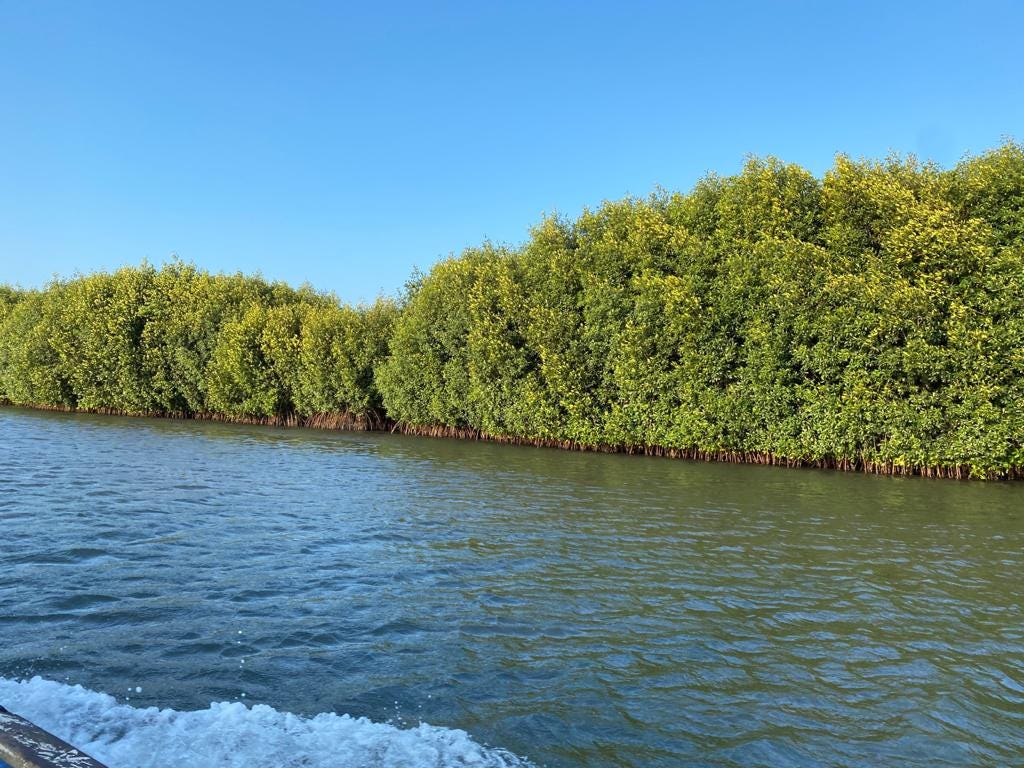In my last post I wrote about one of the projects I’ve been on since 2020 where we planned to use blue carbon credits as a way to fund mangrove restoration in Mexico, and the frustrations and obstacles we faced.
To keep things very short, on that project we learned that:
1. The majority of the world’s degraded, blue, carbon-sequestering ecosystems (mangroves, seagrasses, kelp) cannot be restored via blue carbon credit schemes on their own, due to highly variable, and sometimes surprisingly low sequestration rates.
2. Those who seek to develop such projects have no access to finance for the predevelopment and derisking of these projects, making them extremely difficult to execute. This is because investors are not investing in project development, buyers refuse to share risk of project development, and philanthropies have no interest in derisking projects for the benefit of investors and buyers.
3. This is not to say it’s impossible, but the perfect recipe of geography, policy, politics, local community partnership, and cash-on-hand is necessary.
Here’s How I would fix this, if I could wave a magic wand.
FOR THE BUYERS:
In the voluntary and compliance markets, numerous multinational tech, banking, and energy companies need millions of tons of carbon credits to reach their (mandatory or voluntary) climate goals. I have heard complaints from officers of these companies that, “There aren’t enough projects,” and my previous post explains why that is the case. If I were CSO at one of these companies, I’d vertically integrate project development and build a strong marketing angle around internally-managed carbon projects. Vertical Integration would capture the value of the project as it relates to the company, from a marketing, a goodwill, and public relations standpoint, as well as reduce overall costs for sustainability objectives.
Let’s put some napkin numbers to that idea: The projection is that carbon credit prices will reach ~$100 USD per ton over the coming 5 years (an underestimate by other projections, but for simplicity’s sake let’s keep it a cool 100). For a large purchaser trying to acquire 1 million tons per year, that’s a $100,000,000 annual expense. Over a 30 year period of 1 million tons per year, that’s 3 billion in expenses. Conversely, a series of projects totaling 100,000 hectares of mangrove restoration at $4,000 per hectare and 10 tons carbon per hectare per year, would cost $400,000,000 dollars and supply the 1 million tons per year for 30 years—saving the company a total of 2.5+ billion over that period. Of course, if the predevelopment for those projects was 50 million, the savings would only be $2.45 billion.
That doesn’t account for the goodwill, marketing, and storytelling well executed projects can create, both locally and internationally. Nor does it account for insurance against rising prices or price fluctuations, the ability to trade credits developed in-house, future payments for ecosystem services, biodiversity credits, water credits, nor any benefits to true-cost accounting that may develop in the future. Lastly, it doesn’t account for an earth more conducive to all life (whatever that’s worth).
To me this is a no-brainer; I don’t know why Macquarie, Shell, Microsoft, etc aren’t already doing this; maybe they hate saving money? Or maybe their climate commitments aren’t to be taken seriously?
FOR THE DEVELOPERS:
For those of us intent on using carbon markets to foster more restoration of ecosystems (blue or green), here are some curious models out there of companies that are making carbon crediting work for them, and which hold lessons for the rest of us.
TESLA:
No one thinks of TESLA as a carbon company, but it had $739 million in revenues from carbon credits in Q3 of 2024, approximately 30% of net income. Fundamentally, TESLA would be a lot less profitable without emissions reduction credits, even though they are a car company.
Urchinomics facilitates kelp restoration by wild-harvesting sea urchins, which eat kelp, and which are driving kelp degradation. Importantly, the kelp restoration is passive (rather than active) restoration. Urchins are removed from the ocean, fattened up in an on-shore facility and sold, and the rehabilitated kelp sequesters carbon, providing carbon credits.
KATERI:
Kateri is explicitly a carbon company, working with ranchers to rehabilitate grassland ecosystems. Typically, this results in lower operating costs, more grass, and thus higher profitability to the rancher, even before they split the revenues of the carbon credits, derived from soil carbon sequestration. Some of the experts they work with, like Alejandro Carrillo, have drastically increased the carrying capacity of their ranches while reducing costs per head and animal health.
There are two instructive patterns I want to unpack, with the caveat that only one of these is a publicly traded company and I can’t comment on the financial success of the other two. But I like the models, and this is why:
1. Carbon is not the only revenue stream, or even the primary revenue stream. This is true for Tesla and Urchinomics, whereas for Kateri, the ranches they work with have a primary revenue stream of cattle, and they get more profitable through holistic management of their grasslands. In other words, for all three companies, carbon is a monetizable positive externality to an already lucrative activity that happens to reduce emissions or provide a vehicle for sequestration & ecological health.
2. With both Kateri and Urchinomics, they are directly addressing causes of ecosystem degradation. Urchinomics is playing the role of predator for sea urchins, helping achieve ecological balance and catalyzing kelp rehabilitation. With Kateri, it’s changing management of grassland to improve ranch profitability and restore ecological health, mimicking how ruminants move in the presence of predators. In other words, they have found a profitable way, independent of carbon, to address ecosystem degradation. This turns a problem into a solution, and what is often a big cost in restoration projects, into a profit center.
3. Kateri and Urchinomics both integrate people, employment, and economy into their models of ecosystem rehabilitation, putting land and water managers into positions of stewardship. This is critical, as aligning livelihoods with ecosystem health is foundational to the longevity and durability of those ecosystems (more to come on this in a future post).
There are many other companies i could have highlighted, but I find the three patterns above to be salient, and expect that other efforts following these patterns are much more likely to be successful than pure active ecosystem restoration (such as Delgadito from my previous post). Fundamentally, carbon as an ancillary revenue stream, rather than the only revenue stream, provides significant flexibility and opens doors to landscapes, waterscapes, and ecosystems that cannot be restored through carbon credits alone.







